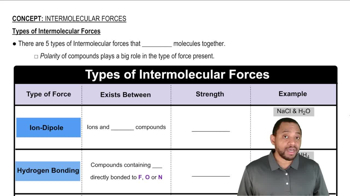True or false: (e) The larger the atom, the more polarizable it is.
Which member in each pair has the stronger intermolecular dispersion forces? (a) Br2 or O2 (b) CH3CH2CH2CH2SH or CH3CH2CH2CH2CH2SH (c) CH3CH2CH2Cl or (CH3)2CHCl
 Verified step by step guidance
Verified step by step guidance
Verified video answer for a similar problem:
Key Concepts
Intermolecular Forces

Dispersion Forces

Molecular Structure and Polarity

Which member in each pair has the greater dispersion forces? (a) H2O or H2S,
Which member in each pair has the greater dispersion forces? (b) CO2 or CO, (c) SiH4 or GeH4.
(a) What atoms must a molecule contain to participate in hydrogen bonding with other molecules of the same kind? (b) Which of the following molecules can form hydrogen bonds with other molecules of the same kind: CH3F, CH3NH2, CH3OH, CH3Br?
Ethylene glycol (HOCH2CH2OH), the major substance in antifreeze, has a normal boiling point of 198 °C. By comparison, ethyl alcohol (CH3CH2OH) boils at 78 °C at atmospheric pressure. Ethylene glycol dimethyl ether (CH3OCH2CH2OCH3) has a normal boiling point of 83 °C, and ethyl methyl ether (CH3CH2OCH3) has a nomral boiling point of 11 °C. (a) Explain why replacement of a hydrogen on the oxygen by a CH3 group generally results in a lower boiling point.
